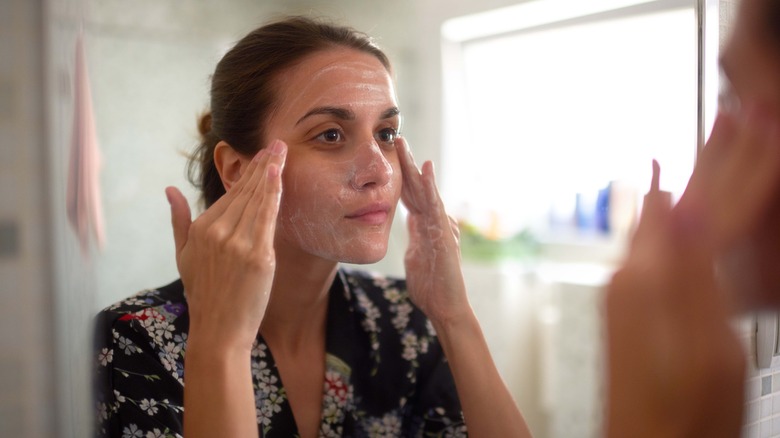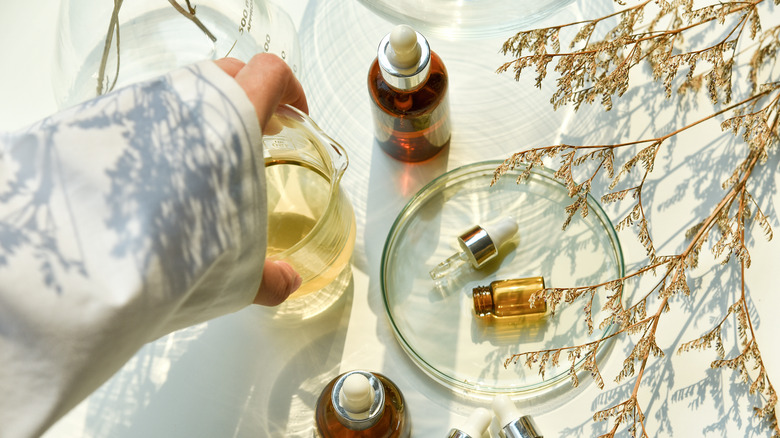Here's When To Use Salicylic Acid In Your Skincare Routine
If you've struggled with breakouts or clogged pores in the past, chances are you've heard of salicylic acid. Clearing up congestion in the skin can be a delicate process, and knowing when to use certain products is key in banishing blemishes for smooth, glowing skin. Salicylic acid, a beta-hydroxy acid, is oil-soluble and works past the build-up of sebum, cleaning out one's pores. "It works by increasing the amount of moisture in the skin and dissolving the substance that causes the skin cells to stick together. This makes it easier to shed the skin cells," Ellen Marmur, a dermatologist at Marmur Medical and MMSkincare in New York City, told Byrdie.
In addition to fighting acne, salicylic acid can benefit your scalp when used as a remedy for dandruff, per a 2010 article published in the Indian Journal of Dermatology. Great for the face and scalp? Sign us up! Still — and as always with skincare ingredients — moderation is key. According to the Cleveland Clinic, one can use salicylic acid every day but generally shouldn't go past two applications per day. Salicylic acid facial washes and serums are great options to get the product into your skin, though both should be followed by a moisturizer. In fact, knowing when to use it in your skincare routine is just as important as what it can do for you.
Use salicylic acid as a cleanser or serum and follow with a moisturizer
Generally, salicylic acid should come after washing your face and before moisturizing. This is most accurate if you're using a serum, but if your face wash contains your daily dose of the ingredient, then you can go straight from that joint step to moisturizing. That said, you'll want to introduce salicylic acid into your skincare routine slowly. Sensitive skin may not be able to handle the ingredient on a daily basis right away, but oily skin may benefit from it more, according to NetDoctor. Try using a face wash or serum containing anywhere from 2% to 4% salicylic acid, per the Cleveland Clinic. Regardless of whether you choose a face wash or opt for a serum, liberally apply moisturizer after for extra hydration. After all, hydrated skin is healthy skin — it can only help.
What's more, the extra hydration is particularly needed because of a side effect of salicylic acid. This skincare ingredient is an effective remedy for blackheads and whiteheads, as it penetrates the pores more deeply than water-soluble beta-hydroxy acids; however, it can dry your skin in the process. "The primary negative side effect of salicylic acid is its ability to irritate and dry skin in those who are very sensitive or those who overuse it," Rachel Nazarian, a board-certified dermatologist in New York City, told Allure.
You can use salicylic acid with retinol and other skincare favorites
You have the go-ahead to use salicylic acid in careful combination with many classic skincare saviors. For instance, retinol actually works quite well with salicylic acid, but you'll want to be careful in how (and when) you apply the products. "Salicylic acid and retinol can be used simultaneously, as long as they are not applied at the same time," board-certified dermatologist and founder of NicholsMD of Greenwich Kim Nichols told MindBodyGreen. "You want to leave enough time in between the application process for each ingredient to deliver optimal results." As such, using one in the morning and one in the evening might be best.
You can also use hyaluronic acid alongside salicylic acid. Hyaluronic acid is a humectant that moisturizes and plumps the skin. "The first is application of humectant ingredients such as hyaluronic acid. Humectants help to draw moisture to the epidermis, either from the air if it is humid enough, or from the underlying dermis in low humidity conditions," dermatologist Dr. Justine Kluk told Cosmopolitan. So, they're actually great partners in leading you to glowing skin.
Since hyaluronic acid is hydrating, applying it after salicylic acid, which clears clogged pores (via Medical News Today), is a wise move. "Many of the most effective skincare ingredients like retinoids, salicylic acid, and benzoyl peroxide tend to be very drying," dermatologist Dr. Whitney Bowe told Good Housekeeping, which is why moisturizing is so important.


